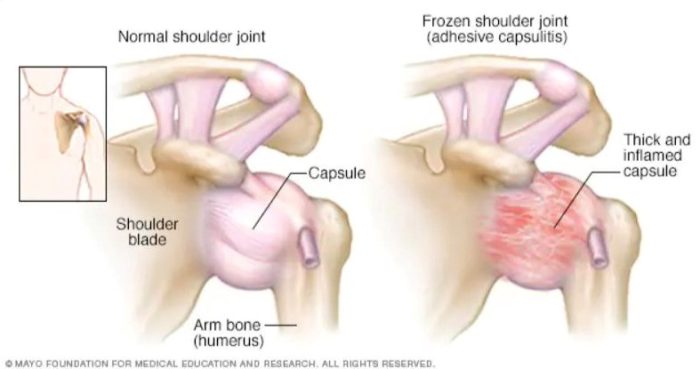Frozen Shoulder and Rotator Cuff Tendonitis: Causes, Symptoms, and Treatment
If you’re experiencing pain or stiffness in your shoulder, you may have frozen shoulder or rotator cuff tendonitis. These two conditions are different from each other and can be caused by a variety of factors, including injury, overuse, and age-related wear and tear. In this post, we’ll go over the causes, symptoms, and treatment options for both frozen shoulder and rotator cuff tendonitis.
What Is Frozen Shoulder? What Causes Frozen Shoulder?
Frozen shoulder, also known as adhesive capsulitis, is a condition that causes stiffness and pain in the shoulder joint
The capsule for the shoulder is important for a number of reasons. It deepens the socket, which makes the shoulder more stable and protects the shoulder from dislocation and provides area for muscles, tendons, and ligaments to attach.
While it’s not entirely clear what the exact cause of frozen shoulder is, it has been noted to occur more in people who have diabetes, post-surgical patients, post-fracture patients, or those with the shoulder immobilized for an extended period of time. Women age 40 and older are also more likely to develop frozen shoulder.
What are the Symptoms of Frozen Shoulder?
The main symptom of frozen shoulder is pain and stiffness in the shoulder joint. This can make it difficult to move your arm, and may cause you to feel a deep ache or shooting pain in your shoulder. The pain and stiffness may worsen over time, and can be especially bad at night. There tend to be three phases of frozen shoulder while you’re experiencing symptoms:
- Freezing
- Frozen
- Thawing
This is where people will note a lot of pain and progressive loss of range of motion. It will seem like the shoulder just starts to stiffen up and you’re not sure why.
This is when the shoulder is just “stuck” and will not move very much. There is typically still pain in this phase but not as intense.
This is when people start to notice the pain subside and the shoulder starts to move a bit more. People also notice some cracking and popping during this phase (this is the capsule loosening and adhesions breaking up).
Each phase can last anywhere from weeks to months and is different for each person.
Treatment for Frozen Shoulder
Treatment for frozen shoulder usually involves a combination of physical therapy and medication. Your physiotherapist may recommend exercises to help improve your range of motion, as well as massage or manual therapy techniques to reduce pain and stiffness. In some cases, your doctor may prescribe anti-inflammatory medications or corticosteroid injections to help reduce inflammation and pain.
What is Rotator Cuff Tendonitis? What Causes Rotator Cuff Tendonitis
Rotator cuff tendonitis is when one of the muscles of the rotator cuff becomes irritated, inflamed, or torn due to overuse or injury. The rotator cuff is made up of 4 muscles; subscapularis, infraspinatus, supraspinatus, and teres minor. The rotator cuff is extremely important for shoulder movement and stability.
Rotator cuff injuries are very common because the shoulder is in use almost constantly, shoulder movements require a lot of combined actions and the use of multiple muscles, and the shoulder isn’t the most stable joint compared to others in our body.
Rotator cuff tendonitis is a condition that causes inflammation in the tendons that attach your shoulder muscles to your upper arm bone. It is often caused by overuse or repetitive motions, such as throwing a ball or lifting weights.
What are the Symptoms of Rotator Cuff Tendonitis?
The main symptom of rotator cuff tendonitis is pain in the shoulder joint. You may also experience weakness in your arm, or have difficulty moving your arm in certain positions. The pain may be worse when you lift your arm or reach overhead, and may be accompanied by a clicking or popping sound.
Typically, there are 3 levels of the rotator cuff tendonitis injury. Your physiotherapist will grade your rotator cuff injury based on the severity of your symptoms.
Grade 1 is pretty mild and will typically feel like some mild to moderate pain with certain movements at the end range or almost feel like you overstretched a muscle. Grade 1 typically takes weeks to heal.
Grade 2 is a bit more serious and you may have pain at rest. Grade 2 tears/tendonitis can take weeks to months to heal.
Grade 3 is typically classified as a tear of one of the muscles in the rotator cuff and may require surgery. A grade 3 will take several months to heal.
Treatment for Rotator Cuff Tendonitis
Treatment for rotator cuff tendonitis usually involves a combination of rest, physical therapy, and medication. Your physiotherapist may recommend exercises to help strengthen your shoulder muscles and improve your range of motion, as well as massage or manual therapy techniques to reduce pain and inflammation. In some cases, your doctor may prescribe anti-inflammatory medications or corticosteroid injections to help reduce pain and inflammation.
A Recap of the Differences Between Frozen Shoulder and Rotator Cuff Tendonitis
- Frozen shoulder has 3 phases (freezing, frozen, thawing)
- Frozen shoulder will be pain and progress loss of range of motion
- Tendonitis presents as pain with certain movements, weakness, and the arm may even “give way” due to weakness.
- Tendonitis is typically after an injury or prolonged use, so usually people know the event that caused it, but not always.
As you can see telling the difference can be tricky and the treatment for these two things is very different. If you think you may have frozen shoulder or rotator cuff tendonitis/ tear, it is important to get a thorough assessment done by a physiotherapist. Our team at Altea Physiotherapy + Wellness is here to help!

